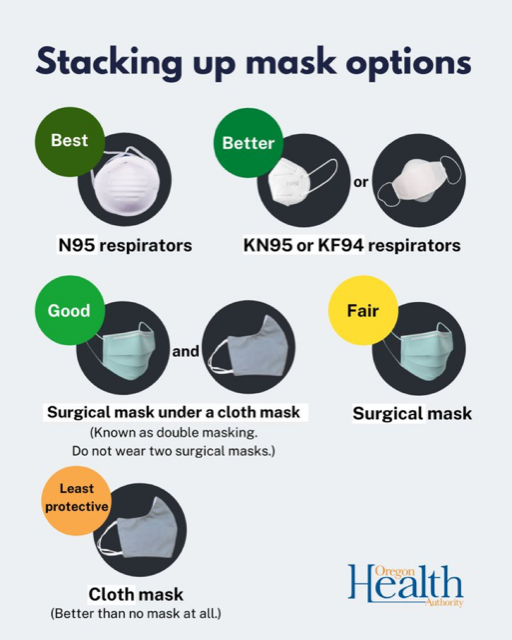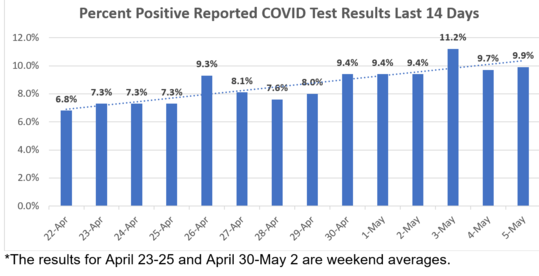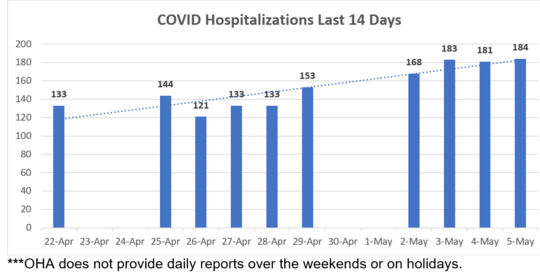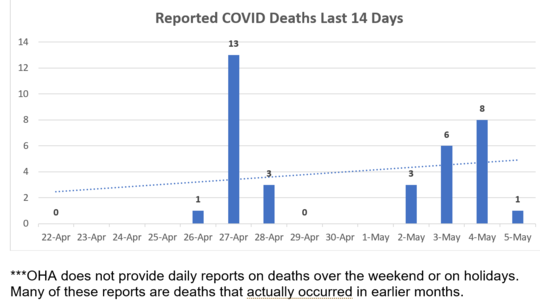|
May 6, 2022
Dear Neighbors and Friends,
I hope that you and your loved ones are doing well, staying healthy, and looking out for your neighbors and friends during this past week.
Tonight’s newsletter starts to fill you in on some of the interim work that I’m involved with right now. Various task forces are underway, working on legislation that will be introduced in 2023. Tonight’s newsletter reports on those related to student success in higher education and the educator workforce shortages.
I also have some comments with respect to Oregon’s position on reproductive choice and equity in light of the recently leaked Supreme Court decision.
On the COVID front, you’ll see that we remain on an upward trajectory for now, particularly in terms of new cases and test positivity rates. These increases appear to be due to a combination of the relaxation of masking and indoor “social-distance” requirements, the increased presence of the new, more contagious variants of Omicron, and waning protection for people who have not been boosted.
I don't know about you, but it seems that more and more people that I know--who managed to avoid infection for the last two years--are now testing positive. The Portland Tri-County area (along with several other counties) has recently moved from "Low
Fortunately, vaccines and access to antiviral medicine are continuing to protect most Oregonians from severe cases of COVID. We are seeing increasing numbers of COVID hospitalizations, but many if not most of those are not people who were hospitalized FOR COVID but who tested positive after being hospitalized for other reasons. COVID cases that require time in intensive care units is also increasing, but very gradually.
As you’ll see in the newly-released OHSU forecast, these increases will continue for the next month before peaking, but will remain within manageable levels for us here in Oregon.
COVID deaths fortunately remain very low here in Oregon.
You’ll find details on all of these developments in tonight’s newsletter, along with the links and graphs that will clarify the current status of the pandemic for you.
Until the next newsletter, please stay healthy and safe. And let me know if you have any questions or thoughts about anything in tonight’s newsletter.
COMING THIS SATURDAY: A Return to the In-Person Constituent Coffee
This Saturday, May 7, is the first Saturday of the month, which means another monthly constituent coffee. This time we’ll be returning at last to an in-person gathering, with coffee and cookies, back at the Hollywood Senior Center, 1820 NE 40th Avenue (from 9 am to 10:30 am).
It will be a chance for me to report on what’s going on in the Capitol, in various work groups, let you know about bills likely to come our way in 2023, get your thoughts on priorities and future action, and prove to one another that yes, we are larger than a zoom postage stamp and we do exist in three dimensions (and can spend 90 minutes without hearing, “YOU’RE ON MUTE!!!”).
Having said that, I know that some of you may not yet be comfortable attending an in-person event like this at this time. For that reason, for the next few months, I’ll be alternating the in-person gatherings with virtual gatherings. So, our June constituent coffee (Saturday, June 4th) will be via zoom. Sorry, for that one you’ll again be responsible for your own coffee and biscuits.
For those of you coming this Saturday, please do bring a mask and be prepared to wear it. For now, that's a requirement/ at the Senior Center. Please do read their recommendations, which I support. Although the number of severe COVID cases has gone way down, case numbers are still increasing here. Those who must wear a mask will feel much more comfortable if those around them are as well.
Looking forward to seeing you on Saturday morning!
Education Work Groups: Joint Task Force on Student Success for Underrepresented Students in Higher Education
I’m spending a lot of time these days traveling around the state and listening to the concerns of students, faculty, staff, and business/community leaders at our community colleges and universities. The purpose of the task force, which was created by HB 2590 in 2021, is to allow the student voice to be heard as we investigate the barriers that are preventing “first-generation” students (i.e., those who would be the first in their families to attend post-secondary education) from accessing and completing their programs. The bipartisan/bicameral task force is expected to develop and recommend policy and funding proposals for the 2023 session that could help create pathways to success for Oregonians fresh out of high school along with those who have “stopped out” of education and training and need a way back in.
So far we’ve had the following site visits:
March 30: PSU (with input from PCC students)
March 31: Mt. Hood CC (again, with input from PCC)
April 25: Lane CC and UO
April 26: Western Oregon U (plus input from students at OSU, Linn-Benton CC, and
Chemeketa CC
Next week we’re off to Eastern Oregon:
May 10: Eastern Oregon U in LaGrande (with input from Blue Mountain CC)
May 11: Treasure Valley CC in Ontario
Still to come: meetings with students at the Central Oregon schools: OSU-Cascades and Central Oregon CC on May 31, then Southern Oregon U and Rogue CC in July.
The meetings—some small-group, others larger-group, along with tours of facilities and student services—have been going from 8 am to 8 pm. The work so far has been both grueling and highly provocative. Despite my own years in higher education, I’ve learned new things every day that we’ve spent meeting with students.
Not surprisingly, we’ve heard a lot about challenges: impossible levels of student debt, the high cost of housing, students experiencing homelessness and food insecurity, and the particular problems that graduate students are facing. We’ve also been exposed to a number of programs that clearly work—but there aren’t enough of them.
In addition to these site visits, the task force meets virtually once a month and hears presentations on current enrollment figures, success rates, the status of state funding and financial aid, along with other issues. There’s also time set aside then for student testimony from students anywhere in the state. The next meeting will be May 19th at 9 a.m.
For more info about the task force, here's the Taskforce website.The public meetings have been recorded if you want to check them out. Also, a wealth of public testimony and reports can be found on each of the meeting webpages.
Please let me know if you have any thoughts about this issue that you’d like to share with me.
Education Work Groups: Workforce Shortages
You may recall that we started working on the growing problem (made both more obvious and worse by COVID) of fewer people choosing to become teachers and other school personnel and more people choosing to leave the profession prematurely. Those discussions led a bicameral, bipartisan work group to come up with HB 4030 during the February session. It focused on short-term strategies (i.e., those that could have an impact this school year and next), allocated nearly $100 million to fund these strategies, and paved the way for more legislation developed for the 2023 session. That longer-term work is now underway.
The original large work group (including legislators, teachers, substitute teachers, administrators, classified staff, college and university educator-preparation faculty, state agencies, associations, and education nonprofits) has been divided into three subgroups, each working on a different but related aspect of the problem: (a) compensation, (b) pathways to education, and (c) retention and working conditions. All three groups are focusing on strategies for diversifying the workforce, along with the particular challenges faced by substitute teachers, classified staff, rural schools, and those working in special education. The groups will be looking at a variety of creative options, including “Grow Your Own” programs (where school districts help classified staff get onto pathways to become classroom teachers or counselors), new models and supports for student teaching, such as teacher apprenticeships, and other ways to make entry into the profession more affordable.
Meanwhile, work on the various short-term strategies in HB 4030 (streamlining licensure, enhancing reciprocity, and support for local districts) are already underway. The bulk of the funding ($78 million) will be going out directly to school districts around the state to enhance district efforts to recruit and retain teachers and classified staff over the coming year. Here's a description of the program, including the kinds of efforts that will be funded. It will prioritize efforts that are already underway, have been successful, and just need to be expanded. That should help in the short run, while we continue to work on new strategies for the long term.
Please let me know if you have any questions or suggestions. I’ll be reporting regularly on this work.
Oregon’s Record on Reproductive Rights
As I’m sure you know, the big news in the intersection of politics and public policy this week was the leaking of what appears to be a decision by the Supreme Court to overturn Roe v. Wade and allow state legislatures to chart their own separate courses in deciding whether or not an individual has the right to choose to terminate a pregnancy.
As someone who believes that an individual’s right to make their own reproductive decisions is a fundamental human right, I strongly disagree with the arguments in this leaked opinion (here it is, with annotations from the Washington Post). Setting aside my disagreement with the way that the opinion is reasoned, the effect of this decision will be disastrous for low-income people in many parts of the country.
That doesn’t include Oregon, I’m proud to say, because of the strong steps we have taken to defend reproductive choice over many years.
Just a few years ago we passed a law, HB 3391 (2017), which explicitly protects Oregonians’ rights to an abortion:
SECTION 8. A public body as defined in ORS 174.109 or, except as provided in ORS 435.225, an officer, employee or agent of a public body may not:
(1) Deprive a consenting individual of the choice of terminating the individual’s pregnancy;
(2) Interfere with or restrict, in the regulation or provision of benefits, facilities, services or information, the choice of a consenting individual to terminate the individual’s pregnancy;
(3) Prohibit a health care provider, who is acting within the scope of the health care provider’s license, from terminating or assisting in the termination of a patient’s pregnancy;
or (4) Interfere with or restrict, in the regulation or provision of benefits, facilities, services or information, the choice of a health care provider, who is acting within the scope of the health care provider’s license, to terminate or assist in the termination of a patient’s pregnancy.
In addition, HB 3391, also known as the Reproductive Health Equity Act, requires that all reproductive health services be available at no cost to all Oregon residents, irrespective of their immigration status.
Ours is among the strongest reproductive choice policies in the nation.
In the recent February session, seeing the growing restrictions on abortion rights in other states, and anticipating the potential reversal of Roe v. Wade, the Legislature created the $15 million Reproductive Health Equity Fund to assist people from other states who need to come to Oregon for access to reproductive care. You can read about this important program here and here..
A few other states have recently passed legislation that would protect their providers from any legal action that might be brought against them by governments or individuals in other states for providing abortion services to people from their states. I’m hearing from constituents asking that we do the same here. At this point it’s not clear that such protections will be necessary. If it turns out that our legal advisors consider this a necessary action for us to take, I’m certain that the Legislature will take prompt action in the next legislative session.
Proud to be an Oregonian.
ON THE COVID FRONT

OHA Biweekly Report: Continued Increases in New Cases and Hospitalizations, Big Reductions in Deaths
The COVID-19 Biweekly Data Report, released on Wednesday, shows an increase in cases and disease-related hospitalizations since the previous biweekly period. It shows a decrease in COVID-19-related deaths.
- OHA reported 12,234 new cases of COVID-19 from April 18 to May 1, more than double the previous biweekly total of 5,980.
- There were 218 new COVID-19-related hospitalizations during the biweekly period, up slightly from 202 reported during the preceding two-week period.
- There were 50 COVID-19-related deaths, much fewer than the 241 reported during the prior two weeks.
- There were 173,792 tests for COVID-19 administered during the weeks of April 17 to April 30, vs. 145,100 for the two weeks before that.
- The test positivity rate for the last two weeks was 7.7%, more than double the 3.6% of the two weeks before that.
Today’s COVID-19 Biweekly Outbreak Report shows 58 total active outbreaks in care facilities, senior living communities and congregate care living settings, an increase from 31 during the previous 2-week period. There were just 9 deaths in congregate care settings over the last two weeks, a big reduction from 49 during the previous 2 weeks.

Weekly County Report: 7 Counties Now at Medium Risk; Continuing Increases in Test Positivity Rates
OHA is no longer providing a weekly county report each Monday, but there are still ways to track this data. According to the CDC Daily Counter (updated each Thursday), seven Oregon counties now have reported infection rates that place them in the Medium Risk category: Benton, Clackamas, Columbia, Deschutes, Malheur, Multnomah, and Washington. The remainder are considered Low Risk still.
Again, we must remember that these are only the tests results that are reported. With the prevalence of home tests, there are certainly many more positive cases out there that have not been reported.
Here’s what the CDC recommends for this category: Stay up to date with COVID-19 vaccines. Get tested if you have symptoms. Wear a mask if you have symptoms, a positive test, or exposure to someone with COVID-19. Wear a mask on public transportation. You may choose to wear a mask at any time as an additional precaution to protect yourself and others. If you are at high risk for severe illness, consider wearing a mask indoors in public and taking additional precautions.
We can also track the test positivity rates for each county and the state as a whole at this dashboard. The test positivity rates reported this week show continued increases.
Among the reported cases, the statewide infection rate has gone from 7.3% last week to 10.4% this week.
Multnomah County is again above the state average, 12.3% 11.5%, up from last week’s 11.5%. The Portland Tri-County average is now 12.0%.
More on Tracking Regional Data
Here is a convenient guide to resources that allow us to stay on top of info from around the state.
New OHSU Forecast Now Shows Ongoing Increases for the Next Month
The current OHSU Forecast Report, published this morning, uses data provided by OHA and others that project how fast the virus may spread in the population and provides projections on possible outcomes, including infection rates and impacts on hospital capacity. The lead author is Dr. Peter Graven, Director of OHSU’s Office of Advanced Analytics. It appears every two weeks.
This forecast shows very little change from the one that was issued two weeks ago. The current increase in cases and hospitalizations will continue to increase—rapidly for cases and gradually for hospitalizations.
The current forecast predicts a gradual increase in hospitalizations (currently 181, up by 50 in the last two weeks) to an estimated 321 a month from now. However, it is worth noting that many if not most of those are not being admitted for COVID but have tested positive upon admission (which does make their in-hospital treatment more complicated). However, even at this level, COVID hospitalizations should still remain well below danger levels for our hospitals. The risk appears more likely to be a result of hospital staff having to stay home because of COVID.
Here are key observations in this week’s report:
- This forecast is largely unchanged from the one that was issued two weeks ago.
- As of May 4, 181 people were in Oregon hospitals with COVID-19, an increase of 50 since April 22.
- Cases have increased significantly in Oregon, and higher in places with high masking rates before mask restrictions were lifted.
- Infection levels in Oregon are some of the highest seen, including during Delta and Omicron.
- The test positivity rate has increased in each of the last six weeks. The most recent complete week (4/24-4/30) had a test positivity of 8.4%.
- Testing levels have not picked up despite the increased positivity rate.
- Wastewater surveillance levels show a change toward plateau, increases, and sustained increases.
- But immunity from vaccines and previous infections means few are resulting in hospitalization or death.
- As of May 4, 5% of occupied ICU beds had COVID patients in them statewide, an uptick from 3% reported in the last forecast.
- Five children were in Oregon hospitals, up from 2 in the last report.
- Flu cases saw a bump in the last month but appear to be declining again.
- The masking rate is largely unchanged in recent weeks. There is some indication of very slight increase in Oregon.
- As it has in the past, the trajectory of the disease here in Oregon appears to be following the trajectory of the Northeast states. Case levels in the Northeast have reached 50 new cases per 100,000 a day. In Oregon, this would be equivalent to 2,150 cases a day.
- Time with others indoors has decreased in Oregon to levels similar to New England and Mid Atlantic.
- The percent of people indicating going to a bar or restaurant indoors has drifted downwards over the last month. The rate in Oregon is similar to that of surge states in the Northeast and Mid Atlantic.
- The primary forecast shows a slight increase in hospitalized patients as the impacts of BA2 and reduced COVID restrictions are experienced. The peak is shown as 321 on 6/10/2022, an increase of 140 from the present number.
- A significant share of these COVID hospitalizations are expected to be incidental, i.e., discovered after the patient has been admitted for another reason.
- The higher levels of infection could affect hospital staffing the way they did during the winter omicron wave.
- Deaths are expected to increase only modestly over the next 2 months due the current wave.
Additional COVID Updates and Links
- The FDA today decided to further restrict the use of the Johnson & Johnson vaccine, due to concerns about blood clots. Here's the latest.
- Use of the antiviral medication Paxlovid to treat COVID has increased tenfold since late February. It has been effective at preventing hospitalization and death in people who already have Covid. Here's more.
- The CDC has just released a study demonstrating the effect that boosters have had in blunting the effects of Omicron on nursing homes.
- Here are the recommendations from the CDC on mask-wearing during travel.
-
Here are the results of new polling from the Kaiser Family Foundation, showing among other things that 1 in 5 parents of young kids are eager to get their kids vaccinated right away.
- A recent article in the Journal of the American Medical Association (JAMA) suggests that regular COVID vaccines, similar to flu vaccines, will likely become part of the "New Normal."
- As is the case in Multnomah County, NYC has entered the Medium Risk Category.
- The FDA has laid out a timetable for approval of a vaccine for children under 5.It appears that it will happen sometime in June.
- Pfizer is hoping to submit its test data for this vaccine by early June.
-
Message from Dr. Fauci: COVID is here to stay but we can control it.
- While the jury is still out on the efficacy of cash incentives to promote vaccination, here's an instance where it worked.
- Here’s information about the rise of yet another COVID subvariant.
- The new variant is likely to become the dominant strain in the U.S.
- And more on why the rise of COVID mutations is not slowing down.
- A recent Washington Post article reports that the biggest risk of severe COVID is no longer among the unvaccinated (though they remain at high risk) but among the elderly and immunocompromised who have been vaccinated but not boosted.
- The CDC reported last week that more than 50% of Americans have contracted COVID at some point. What exactly does this mean?
- Paul Offit, MD, Director of the Vaccine Education Center at Children's Hospital of Philadelphia, discusses vaccination, myocarditis, and COVID-19 illness in younger age groups. He argues that messaging to parents needs to be greatly improved.





Here again are some COVID resources that you will find useful:
If the above links are not providing you with answers to your questions or directing you to the help that you need, please consider me and my office to be a resource. We’ll do our best to assist you or steer you in the right direction.
Want to See Past Newsletters?
If there was COVID-related information in a past newsletter that you want to go back to, but find you’ve deleted it, you can always go to my legislative website (senatordembrow.com), click on “News and Information,” and you’ll find them all there. Also, if someone forwarded you this newsletter and you’d like to get it directly, you can sign up for it there.
Best,
 Senator Michael Dembrow
District 23
email: Sen.MichaelDembrow@oregonlegislature.gov
web: www.senatordembrow.com
phone: 503-281-0608
mail: 900 Court St NE, S-407, Salem, OR, 97301
|